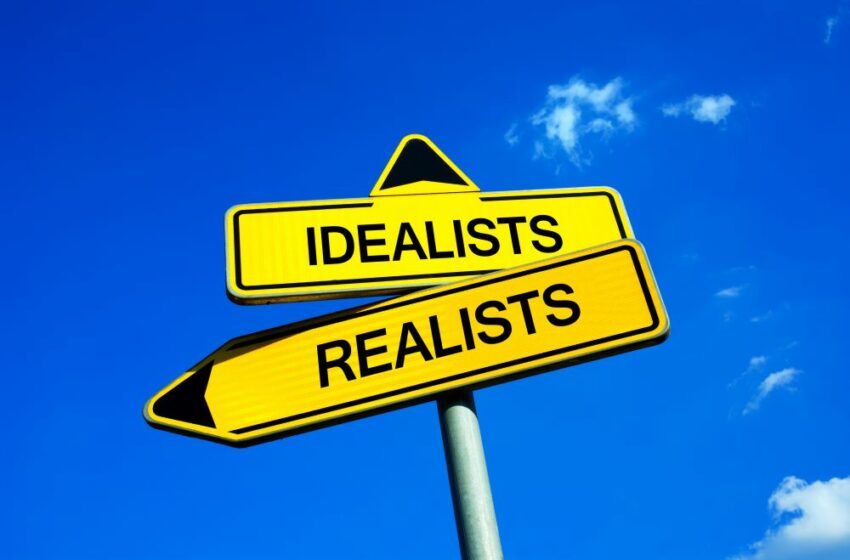Realists and Idealists
- Clive Bates Harm Reduction Print Edition
- June 1, 2024
- 0
- 10 minutes read

Image: M-SUR

We should celebrate ‘realists’ and beware of ‘idealists.’ Idealists do well in the rhetorical world of goal setting, aspirations and optics while realists do better in the real world. The problem is that the idealists obstruct the realists.
By Clive Bates
On April 22, the British Medical Journal and a new investigative publication, The Examination, funded by billionaire activist Michael Bloomberg, declared a victory. Their “investigation” had shut down a new continuing medical education program in smoking, tobacco and nicotine offered by the respected medical information provider Medscape. The course had been running for a few weeks and had proved popular with participants. It had been designed to address an essential unmet educational need: the widespread confusion among healthcare practitioners about the causes of disease, the nature of nicotine use and the options available to reduce the harms. It’s hard to imagine more valuable and actionable public health and preventative insights for practitioners. So why close it down? Simple: The initiative had been funded at arms-length by a tobacco company, Phillip Morris International, which played no role in developing the content.
It’s worth pausing to examine what has been achieved here. The objection to tobacco company funding in the case is essentially aesthetic. To some activists, it just doesn’t look right. Tobacco companies involved in ending smoking? Weird! No one has presented material objections to the course content. I have no doubt that it was a sincere effort to raise the lamentable standard of medical knowledge in this area delivered by experienced professionals. The idealists were successful in burning this initiative to the ground. But here’s the point: Like arsonists, they didn’t build anything. They have left nothing where there was previously something useful. The activists have made their impassioned denunciations, expressed their righteous anger and moved on. But it’s an empty victory because the confusion and misinformation remain, and the opportunity to do better for the public and patients has been squandered.
I chose this recent example because it illustrates a more general problem with activism. The pursuit of idealistic goals is not necessarily heroic and may not be benign. It can make matters worse with real-world costs for people and the environment. Let’s take three examples from outside the nicotine field to illustrate the point, then return to nicotine.
First, the green opposition to nuclear power. In their quest for an idealist vision of a 100 percent renewable system based mainly on solar and wind power, greens have opposed a proven, reliable, low-carbon form of electricity generation. By creating fear and foreboding about nuclear risks, activists and regulators have made the technology exceedingly expensive and difficult to deploy, making fossil fuels relatively more attractive. The French experience from the 1960s shows successful large-scale nuclear deployment, but idealistic opposition has driven the costs upward since then. Finally, idealists are starting to feel the heat from the climate realists.
Second, activists with an in-principle opposition to genetic engineering recently stopped the deployment of genetically modified golden rice, which is rich in Vitamin A, in the Philippines. Vitamin A deficiency is implicated in up to 500,000 cases of blindness in young children annually in Asia and Africa each year. Maybe it would be better to lift poverty and improve nutrition more systematically, but how long would that take, and how many people would be harmed waiting for the idealists’ more prosperous and just society? Like adding fluoride to water to protect dental health, golden rice would have added Vitamin A to the food supply system, creating widespread health benefits. Now, people will suffer instead.
Third, local and international nonprofit organizations lobbied tenaciously for Sri Lanka to switch its agricultural system to become exclusively organic, backed up by a ban on the use of agrichemicals. They got their way, but it did not go well. The food supply crashed, the people went hungry and rioted, and the government fell.
In each case, a noble aspiration, an eye-catching slogan or a grand commitment has stood in the way of making more mundane but pragmatic progress at the expense of human well-being. Some further characteristics are evident:
- Idealists evade the messy and distinctly realist business of trade-offs, waving away the concerns of realists as a lack of ambition or “industry talking points.”
- The idealists rarely accept accountability for the unintended consequences of their positions—the fault is with others for not trying hard enough or spending enough to match the idealists’ aspirations.
- The idealists often receive an easy ride in the media, especially when they evoke youth to make their case. Did anyone ever put hard questions to Greta Thunberg?
Turning now to the battle between idealists and realists in the world of tobacco and nicotine.
First, the nicotine-free society. The idealists in tobacco control would like to rid us of this relatively benign recreational drug. Sorry, but that will not happen, and there is no reason why it should. People use nicotine because it makes them feel better, for its pleasurable, functional and therapeutic attributes. However, demonizing nicotine and treating all nicotine products as if they are equally harmful will obstruct the realists’ efforts to address the significant harm caused by smoking. The idealists take each ban and blockage of any nicotine product as progress to their larger goal. How else can we explain the sustained ban on snus in the European Union?
Second, defending the purity of youth. Though all idealists have been teenagers at some point, few seem to understand them. Some young people have a propensity for risk-taking with drugs, alcohol, sex and other reckless behaviors, and yes, to use nicotine. But the idealists have adopted variants on the mantra “no teen should use nicotine.” Fine, that might be good advice. But what if they go further and try to make that a reality with various forms of prohibition, restrictions and misinformation? The trouble is that the much larger adult market will be bent out of shape by misguided efforts to protect youth. There will be more smoking, more illicit trade and more risky workarounds, including among youth. The realist goal of providing a lawful, acceptably safe, proportionally regulated nicotine market is undermined by the fervor of the idealists, with worse results for everyone.
Third, the knockout blow. Collectively known as “endgame” measures, these grandiose schemes would abolish cigarettes as we know them, close nearly all retail outlets, impose shrinking production and import quotas, or ban sales to anyone born after a specific date. They have this in common: They won’t be implemented, they won’t work as expected, or they will have little useful effect. But they will obstruct the realists because these ideas divert political, regulatory, scientific capital and creativity into unworkable schemes and away from pragmatic, if humble, measures that will work. Worse, they occupy the imaginary sunlit uplands with a fake utopia, creating a mirage where there should be an achievable destination—a stable, lawful, well-regulated market for a popular drug.
Fourth, the pursuit of paper tigers. I recently submitted evidence to an inquiry into new legislation in South Africa. The new law had been drafted as model anti-vaping legislation with extreme restrictions and penalties and tell-tale fingerprints of American activists. The contrast between the precision control, on paper, of the new law and the chaotic reality of South Africa’s giant illicit market is matched only by that of Australia’s new legislation that tries to ban vapes even harder, even though over 90 percent of the Australian vape market is already illegal. When the idealists declare a prohibition in law on paper, actual or de facto, it doesn’t make the banned products disappear. However, it does mean that more modest regulation becomes impossible because most of the market is unregulated and illicit.
Fifth, why don’t they stop making cigarettes? A common idealist theme is that if tobacco companies are serious about health, they should just stop making cigarettes. It sounds superficially plausible and inspiring. In reality, these companies have a legal duty not to destroy their shareholders’ money. If they tried, three things would happen: The management would be fired, the company would be taken over, or the productive assets and brands would be sold as a going concern. All to no effect. The realists recognize the need for a transformation, moving the market to noncombustible nicotine products and diversifying the business into non-nicotine activities in which they have an advantage, keeping their shareholders on board throughout.
Finally, conflicts of interest (COI). Idealists divide the world into independent and industry science. They see industry conflicts of interest as disqualifying from scholarly societies and journals. Yet, conflicts arise from every funding source or institution with policy preferences. An industry COI may be no more than a sign of having valuable marketable capabilities. The realists want to engage with anyone with specialized knowledge and, with due skepticism, to learn from their insights. The idealists prefer to erase them from the discourse and pursue purity at the expense of knowledge.
To summarize, the idealists will resist the realists, and everything will be worse.
